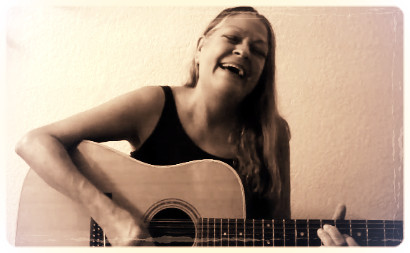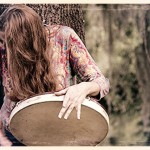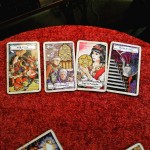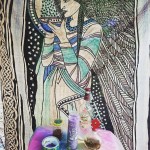 I got the bright idea to run around interviewing Pagan musicians about magic, music, and their spiritual practice at Caldera Fest and it was every bit as awesome as I hoped it would be, despite some technical issues. Mama Gina is one of the twenty Pagan performers at the event, and also one of the contributors to the newly released Green Album. You can find out more about her at her website.
I got the bright idea to run around interviewing Pagan musicians about magic, music, and their spiritual practice at Caldera Fest and it was every bit as awesome as I hoped it would be, despite some technical issues. Mama Gina is one of the twenty Pagan performers at the event, and also one of the contributors to the newly released Green Album. You can find out more about her at her website.
Part 1, where she talks about craft both musical and magical, is here.
SA: Earlier you said that you had studied Kabalah and a little bit of ceremonial magic, and we touched on the idea that some of your inspiration was coming from that, which I found really interesting.
MG: And you said that you thought Kabalah was a little dry…
SA: Yeah, I realized later that it just has that reputation.
MG: It does, and I’ll tell you that a lot of ceremonial magicians did give it that reputation. [laughs] They really want it to be very precise. And Kabalah is not that precise to me. There is a precision to it, but when you experience and live Kabalah, it gets messy. It gets messy. I really work very hard…I’m lousy at it, I’m not saying I’m a pro…but I work hard at walking and living my Kabalistic principles and spending a lot of time being mindful. Sometimes that looks like Zen Buddhism, you know? And sometimes it looks like a coloring book. For me Kabalah is not a bunch of straight lines and circles like we see on the Tree of Life, it’s really something very experiential. The only way that I think you really truly learn the principles is if you apply them to your life.
SA: I found that when I came to it, and I did so after I had done a lot of experiential, very ecstatic stuff…Reclaiming and Faery is where I live, right?…But because I have a lot of life experience, more than most people let’s just put it that way…for me, I could see why the tradition is that you have to be a certain age and all that, because the big epiphany of it for me was all of the connections. You have to have the content, it’s categories that you can put things in conceptually, but you can’t just know it intellectually, you have to have felt it.
MG: You really have to have some experience to come to this, I absolutely agree, and that’s a really good insight. The old story was was that you had to be forty, you had to be male, you had to be married, you had to have kids before you could study Kabalah, and that’s old-school on the Jewish side. I actually had a rabbi tell me once that women didn’t need to study it because they were already living the mysteries of Kabalah. It comes from a root that means to receive, and women are the receivers of all of this amazing divine love, and they turn around and make babies, they let it come through them and send it out into the world. Men needed to live those four decades, be married so they know what it is to give and receive love, they needed to have children so they understand that principle of growth, expansion and contraction. Men take a little bit longer to learn those principles, but women are already living them. It sounds a little patriarchal but I decided it was a good opinion and I was going to keep it, that it made sense. If you look at the Tree of Life all over it there are all of these things about expansion and contraction. We are always either growing out or we’re growing inward. There is stillness, but there is no stagnation. I have never found a God or Goddess of stagnation. They don’t do that. [laughs] And if we work with the Gods and Goddesses, or they work with us, we don’t do that, because we don’t get the opportunity to be stagnant.
SA: How does that relate to your creative process?
MG: So much goes into it, because….well, I’ll tell you a story. I was reading a book on Gnostic Kabalah a few years ago. There was this meditation around Tifaret, the heart center, in the tree the sixth sphere. The meditation said to breathe in the darkness, fill yourself with it, and take your own divine light that exists within you, turn it on and shine it on all that darkness, transmute it, turn it back into light, and send it out. Now, my initial reaction was, “Oh, I’m not going to breathe in all that dark, because that’s not what we do, we breathe in the light, we send out the nasty stuff, we breathe in the light, we send out…” That’s what we’re taught to do. I read this meditation and it cracked me wide open. Because my first thought was, “oh hell no, I’m not ever going to do that.” Then immediately I sat down and thought, “no wait a minute, this makes perfect sense.”
I have written songs around that concept , because it changed my life. It changed my life to realize that I can change the world with a single breath. I can inhale and identify the darkness in me and then I can exhale and send out the light because I have transmuted it myself, because I am divine and I can do that. Nothing can hurt me. I can feel for the darkness in my neighbor next to me, or the event that’s happening around me and pull it into me and breathe it into light and let it go. That rocked my world. I had songs as far back as when I was in a rock band twenty years ago that became songs that were about that. Not in an overt way, but allowing me to say these things in a creative way. It’s marked so much by this.
SA: You were telling me that there was a different way of working with Kabalah, and that was how you wound up going back to making music for a living.
MG: That’s actually the Cube of Space, that’s a different, three-dimensional construct based on this poem called the Sefer Yetzirah. Through the aleph-beth, through the vibration of each letter, we grow this cube of space. The cube has all of these pieces and parts to it, it has dimension from the center to above and the center to below, from the center to the west and the center to the east, the center to the north and the center to the south, and now we have this framework, where there’s this constant flow and all possibility, and now we start placing boundaries on the cube, six boundaries around the cube and the center becomes a boundary. So we…we pretend to stop the flow. Because if it keeps flowing, it’s going to break the vessel that we’re building. It’s all an illusion, I will readily admit it, but it’s an illusion that’s extraordinarily valuable in our physical state. The last twelve letters are the interstices on the cube. You have twenty-two letters in this creation story and I’m a firm believer that if you use a creation story, you learn it and it doesn’t have to be the Sefer Yetzirah, it can be, Native American turtles all the way up and turtles all the way down, right? But if you learn that creation story and start to apply those principles to your life, you can now create something because we’re all creators, and we’re really good at it. Some of us are really good at creating crap over and over again, we’ve become masters of creating stuff we really don’t want. But when you learn this creation story and piece by piece you ask yourself questions that arise with every building block, “What do I want to stretch up for? What do I want to stretch within and down for? What is worth reaching into the East and bringing to my work? What is worth reaching to the West and bringing in through the Wheel in Tarot”…you know, there are all these connections. I have run three study groups over the last seven to ten years, they take about a year and a half to run. I facilitate them, I don’t teach them, everybody is completely active. But the second study group that I did, the direct result of that study group is the life that I’m living now. I began making my choices about how I wanted to live my life, and how I wanted to make being a Pagan singer-songwriter a reality. When you work through that for so long, you really do start to create. I built my world, I stopped making excuses about why my world was not the world that I wanted, and I built it. There aren’t a lot of books about the Cube of Space, it’s a very very esoteric piece. Someday…I have my book of notes that is about five inches thick from the last three study groups of all original material, and some day there will be a work book. I don’t want to make it for people who read on an esoteric level, I want to make it so that people understand it and they can use it so that they can create the world. Apply that creation story and make it happen.
SA: You know, I write poetry and fiction…sometimes limitations make the art better.
MG: Absolutely. You can’t finish something if the flow never stops. There comes a point where you have to acknowledge the flow, the imagination, the spark, this is amazing but at some point you have to apply some kind of boundary. At some point you have to be done, right?
SA: Yes, you can write a book forever, and you’ll never be finished. You have to let it go.
MG: You keep saying you’re an author, but you never have a book because what you’ve got is a run-on sentence that will never be finished. Or you can put yourself on a schedule. Don’t edit while you write, but know that there’s going to be a day when you’re going to start editing and chopping and getting rid of things because that’s part of the creation process too. If you think about it, in the Cube of Space there are correspondences with the twenty-two letters in the Hebrew alphabet which also correspond to the twenty-two major arcana of the Tarot, and they’re all in there. We have the Death card, the Tower card, all of these cards that say “let’s slice and dice a while, let’s chop things up, let’s break things.” And that’s OK. You need all of that stuff, you need those boundaries and you need to figure out what goes and what stays.
I had a discussion with a friend the other day, and we were talking about risks that we would never take now. For instance, I would never jump out of a plane now. I have neuropathy in my feet, I’m fifty-four, this ain’t happening. It hurts enough just to walk, I’m not jumping out of a plane. But I think I’ve taken two incredible risks in my life and we talked about that. He said “what’s the biggest risk you have taken?” and I said, “Quitting my day job, cashing in my 401k, and saying I was going to go out on the road and play music…that if it was one person at a time I was going to do it.” I also have a beautiful son, he’s twenty-four. That was a risk. Nobody can tell you what that’s going to be like until you have a child [laughs]. And you don’t even know it’s a risk sometimes, you just go “oh this feels good, that orgasm feels so good oh yeah!” and then all of a sudden you’re going “My God, this is the craziest thing I’ve ever done in my life.” He’s probably taught me more than anything. I’m not preaching that people need to take risks, but I do think…I see so many people and they look at me and say, “Oh, you’re so amazing.” No, no. I was more afraid to stay in the life I had in corporate America. I was sick every day, it was not a good thing. Find something you love. Carve out some time to do it and stop making excuses. You don’t have to quit your day job, you don’t have to do this thing you love exclusively, but you have got to find something that you love and step into that and make that your reality.
Coming up: SJ Tucker, Kyddryn Gaia of Spiral Rhythms, Robin Renée, Arthur Hinds, Damh the Bard, and more!
Find me on Facebook! A Word to the Witch
















